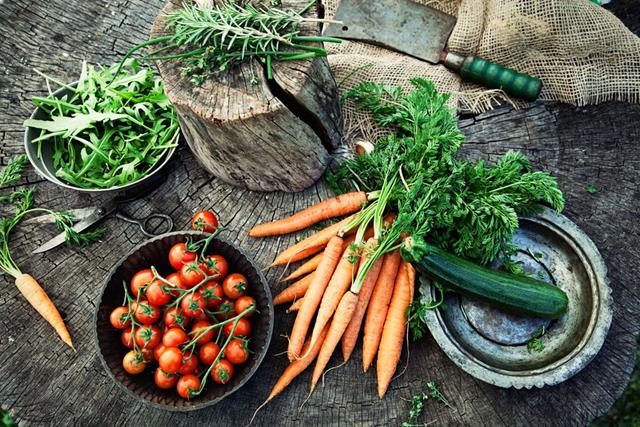Vegetables for partial shade gardens are an excellent choice for gardeners looking to make the most of challenging growing conditions. Partial shade gardens refer to areas that receive sunlight for only a few hours each day, making it crucial to select vegetables that can thrive in this type of environment. Choosing the right vegetables is essential for ensuring a successful harvest and getting the most out of your garden space.
In this article, we will explore the best vegetables for partial shade gardens, providing a comprehensive list of options including leafy greens, root vegetables, and herbs that are well-suited for these conditions. Additionally, we will cover tips for planting and caring for vegetables in partial shade, as well as the benefits of growing vegetables in this type of environment.
Gardeners will also find helpful advice on designing a garden layout that maximizes the potential of partial shade, addressing common challenges and providing solutions to overcome them. We will also highlight specific vegetable varieties that are recommended for partial shade and share success stories from experienced gardeners to provide inspiration and guidance.
Whether you’re dealing with limited sunlight or simply want to make the most of your garden space, this article will help you cultivate a thriving vegetable garden in partial shade.
Best Vegetables for Partial Shade Gardens
When it comes to growing vegetables in partial shade gardens, it’s crucial to choose the right plants that can thrive in these conditions. While many traditional vegetable crops require full sun to flourish, there are plenty of options for those with gardens that receive limited sunlight. In this section, we will highlight a comprehensive list of vegetables that are well-suited for partial shade conditions, including a variety of leafy greens, root vegetables, and herbs.
Leafy Greens
Leafy greens are an excellent choice for partial shade gardens due to their ability to tolerate less sunlight compared to other vegetables. Options such as spinach, kale, and lettuce can thrive in areas with dappled sun or filtered light. These versatile greens can be used in salads, smoothies, and cooked dishes, making them a valuable addition to any garden.
Root Vegetables
Certain root vegetables also perform well in partial shade environments. For example, carrots and beets are known for their ability to develop in less sunny conditions. When grown in partial shade, these crops may take longer to mature than those grown in full sun but can still produce impressive yields if given proper care.
Herbs
Many herbs can adapt to partial shade and provide gardeners with fresh flavors for cooking and garnishing. Shade-tolerant herbs like mint, parsley, and chives can add fragrance and taste to dishes while thriving in areas with limited direct sunlight.
By choosing the right combination of leafy greens, root vegetables, and herbs that are suitable for partial shade gardens, gardeners can create bountiful harvests even in spaces with reduced sun exposure. With careful selection and proper care, delicious homegrown produce can be enjoyed throughout the growing season.
Planting and Care Tips
When it comes to planting and caring for vegetables in partial shade gardens, there are several important tips to keep in mind. One of the most crucial factors to consider is soil preparation. Since partial shade gardens may have limited sunlight, it’s essential to ensure that the soil is nutrient-rich and well-draining.
Adding organic matter such as compost or aged manure can help improve soil fertility and structure, providing a healthy environment for vegetable growth. Additionally, incorporating a balanced fertilizer can supplement any potential nutrient deficiencies caused by reduced sun exposure.
In terms of watering, vegetables in partial shade may not require as much water as those in full sun. However, it’s important to monitor moisture levels regularly and provide consistent, even watering to prevent stress on the plants. Mulching around the base of the vegetables can also help retain moisture and regulate soil temperature, especially during periods of intense heat or dryness.
When it comes to maintenance, regular monitoring for pest and disease issues is vital in partial shade gardens. Given the reduced sun exposure, certain pests and diseases may be more prevalent, making proactive management essential. Utilizing natural pest control methods and practicing good garden hygiene can help mitigate these risks and ensure the health of the vegetable plants.
Overall, with proper attention to soil preparation, watering practices, and maintenance routines, vegetables in partial shade gardens can thrive and produce bountiful harvests. By understanding the unique needs of these plants in this environment, gardeners can cultivate successful and abundant crops while making the most of their partially shaded garden spaces.
Benefits of Growing Vegetables in Partial Shade
Growing vegetables in partial shade offers several benefits that make it a suitable option for many gardeners. One of the primary advantages of partial shade is the reduced sun exposure, which can be beneficial for certain vegetable plants. While most vegetables thrive in full sun, some may struggle and even wither under intense heat and sunlight. By opting for vegetables that can thrive in partial shade, gardeners can ensure better plant health and productivity.
In addition to reduced sun exposure, partial shade gardens often experience fewer pest issues compared to gardens with full sun exposure. Many common garden pests thrive in hot, dry conditions, which may not be as prevalent in shady areas of the garden. This can result in less damage to vegetable plants and a more enjoyable gardening experience for the grower.
Furthermore, growing vegetables in partial shade allows gardeners to make the most of challenging garden spaces. Not all gardens have access to full sun throughout the day, whether due to surrounding structures or large trees casting shadows. By choosing vegetables that are well-suited for partial shade, gardeners can maximize their gardening space and still enjoy a bountiful harvest.
Overall, the benefits of growing vegetables in partial shade make it a practical and rewarding option for gardeners looking to make the most of their available growing space while minimizing potential challenges associated with intense sunlight and pest issues. With careful consideration and planning, a thriving vegetable garden can be achieved even in partially shaded areas.
Designing a Partial Shade Garden
When it comes to designing a garden layout for partial shade, there are several factors to consider in order to maximize the potential of the space and ensure that vegetables thrive. Companion planting is an essential technique that involves growing different plants alongside each other to provide mutual benefits, such as deterring pests or enhancing soil health. For partial shade gardens, consider planting shade-tolerant vegetables with taller plants that can provide them with the necessary protection from the sun.
Another important aspect of designing a partial shade garden is utilizing vertical space effectively. Since sunlight may be limited in a partial shade environment, growing vegetables vertically can help increase overall sun exposure for the plants. Options such as trellises, arbors, and hanging baskets can be used to support climbing vegetables like peas, beans, or cucumbers. Additionally, hanging containers or wall-mounted planters can also be used for growing herbs and leafy greens in areas with partial shade.
Companion planting and vertical gardening are key elements in creating a successful layout for a partial shade garden. By carefully planning the arrangement of different vegetable varieties and making use of available space effectively, gardeners can create a thriving environment for their vegetables while maximizing the potential of partial shade conditions.
| Technique | Description |
|---|---|
| Companion Planting | Growing different plants alongside each other to provide mutual benefits. |
| Vertical Gardening | Utilizing vertical space effectively by using trellises, arbors, hanging baskets, and wall-mounted planters. |
Common Challenges and Solutions
When it comes to growing vegetables in partial shade gardens, there are a few common challenges that gardeners may encounter. However, with the right approach and solutions, these challenges can be easily overcome to ensure a successful harvest. Here are some of the most common challenges and practical solutions for growing vegetables in partial shade:
1. Lack of Sunlight: One of the main challenges of growing vegetables in partial shade is the limited sunlight exposure. To address this, it’s important to choose vegetables that are specifically suited for lower light conditions. Opt for leafy greens such as lettuce, spinach, and kale, which thrive in partial shade. Additionally, consider using reflective mulch or light-colored containers to help maximize sunlight exposure for your plants.
2. Slower Growth Rates: In partial shade gardens, vegetables may take longer to reach maturity due to reduced sunlight. To combat this challenge, focus on providing consistent and adequate water and nutrients to support healthy growth. Consider using a slow-release fertilizer specifically formulated for vegetables to ensure they receive the necessary nutrients during their extended growing period.
3. Increased Susceptibility to Pests and Diseases: Partial shade environments can create conditions that are favorable for pests and diseases to thrive. To prevent pest issues, practice good garden hygiene by removing any damaged or diseased plant material regularly. Additionally, consider incorporating companion planting with natural pest deterrents such as marigolds or garlic around your vegetable crops.
By being aware of these common challenges and implementing practical solutions, gardeners can successfully grow a variety of vegetables in partial shade gardens while maximizing their harvest potential.
Recommended Varieties
When it comes to growing vegetables in partial shade gardens, choosing the right varieties is crucial for a successful harvest. Fortunately, there are several vegetable varieties that thrive in partial shade conditions, offering gardeners plenty of options to choose from. Here are some recommended vegetable varieties that are well-suited for partial shade, along with their unique characteristics and growing requirements:
- Spinach (Spinacia oleracea): Spinach is an excellent choice for partial shade gardens, as it prefers cooler temperatures and can tolerate less sunlight than other leafy greens. It can be grown in containers or directly in the ground, making it a versatile option for gardeners with limited space.
- Carrots (Daucus carota): Carrots are root vegetables that perform well in partial shade, especially in regions with hot summers. They require well-drained soil and regular watering to produce sweet and flavorful roots. Look for shorter varieties that are ideal for smaller garden spaces.
- Mint (Mentha spp.): Mint is a hardy herb that thrives in shady areas and can even tolerate moisture-retentive soils. It’s a great addition to any partial shade garden, providing aromatic leaves that can be used for culinary purposes or herbal teas.
In addition to these specific vegetable varieties, it’s important to consider the overall growing requirements of each plant when selecting varieties for a partial shade garden. Pay attention to factors such as soil type, watering needs, and mature size to ensure that your chosen vegetables will thrive in their environment.
Ultimately, by choosing the right vegetable varieties for your partial shade garden, you can enjoy a bountiful harvest while making the most of challenging garden spaces where direct sunlight may be limited. With careful selection and proper care, these recommended varieties can contribute to a thriving and productive garden even in partially shaded areas.
Success Stories
In conclusion, growing vegetables in partial shade gardens can be a rewarding and successful endeavor with the right knowledge and approach. By selecting the best vegetables for partial shade gardens and following planting and care tips, gardeners can create thriving and productive garden spaces in areas with limited sunlight. The benefits of growing vegetables in partial shade, such as reduced sun exposure and fewer pest issues, make it a valuable option for maximizing challenging garden spaces.
Designing a partial shade garden layout that maximizes the potential of these environments is crucial for success. Utilizing companion planting and vertical space can help optimize the use of available sunlight and create a diverse and abundant vegetable garden. Additionally, addressing common challenges with practical solutions is essential for overcoming any obstacles that may arise when growing vegetables in partial shade.
Real-life success stories from experienced gardeners serve as inspiration for those looking to embark on their own journey of growing vegetables in partial shade gardens. These stories showcase the potential for thriving vegetable gardens in partially shaded areas, providing valuable insights and motivation for readers to pursue their own successful gardening experiences. With the right planning, care, and determination, anyone can achieve success in growing vegetables in partial shade gardens.
Frequently Asked Questions
What Vegetables Can Tolerate Partial Shade?
Some vegetables that can tolerate partial shade include leafy greens like lettuce, spinach, and kale, as well as root vegetables like beets and carrots. These plants can thrive with about 3-6 hours of sunlight.
What Vegetables Only Need 4 Hours of Sun?
Certain vegetables only need about 4 hours of sun to grow successfully. These include crops like radishes, turnips, and mustard greens, which can still produce a good harvest with limited sunlight compared to other sun-loving vegetables.
What Vegetables Grow Well in the Morning Shade?
Vegetables that grow well in morning shade are ones that prefer cooler temperatures. This includes crops like broccoli, cauliflower, and cabbage which benefit from the protection from harsh afternoon sunlight and can thrive in the gentler morning shade.

If you’re looking to get into vegetable gardening, or are just looking for some tips on how to make your current garden better, then you’ve come to the right place! My name is Ethel and I have been gardening for years. In this blog, I’m going to share with you some of my best tips on how to create a successful vegetable garden.





